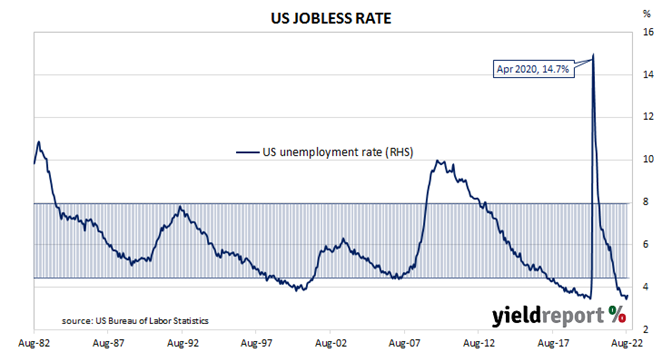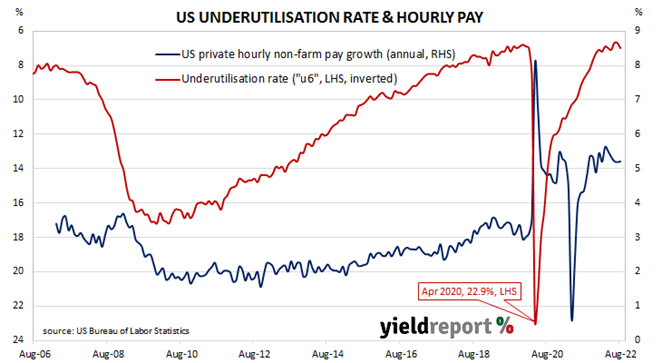Summary: Non-farm payrolls up 315,000 in August, slightly more than expected; previous two months’ figures revised down by 107,000; jobless rate rises to 3.7%, participation rate rises to 62.4%; may be tentative sign of easing labour market tightness; jobs-to-population ratio ticks up to 60.1%; underutilisation rate rises to 7.0%; annual hourly pay growth steady at 5.2%.
The US economy ceased producing jobs in net terms as infection controls began to be implemented in March 2020. The unemployment rate had been around 3.5% but that changed as job losses began to surge through March and April of 2020. The May 2020 non-farm employment report represented a turning point and subsequent months provided substantial employment gains. Changes in recent months have been generally more modest but also well above the long-term monthly average.
According to the US Bureau of Labor Statistics, the US economy created an additional 315,000 jobs in the non-farm sector in August. The increase slightly more than the 300,000 which had been generally expected but considerably less than the 526,000 jobs which had been added in July after revisions. Employment figures for June and July were revised down by a total of 107,000.
The total number of unemployed increased by 344,000 to 6.014 million while the total number of people who are either employed or looking for work increased by 786,000 to 164.746 million. These changes led to the US unemployment rate rising from 3.5% to 3.7% as the participation rate increased from July’s rate of 62.1% to 62.4%.
“The increase in the participation rate and a softening in average hourly earnings may be a tentative sign that intense labour market tightness is starting to ease slightly, and [it] eases some of the fears stemming from other indicators such as job openings,” said NAB senior economist Tapas Strickland.
US Treasury yields fell on the day, especially at the short end. By the close of business, the 2-year yield had shed 12bps to 3.39%, the 10-year yield had lost 7bps to 3.19% while the 30-year yield finished just 1bp lower at 3.35%.
In terms of US Fed policy, expectations of a steeper path for the federal funds rate over the next 12 months softened. At the close of business, September contracts implied an effective federal funds rate of 2.53%, 20bps higher than the current spot rate, while November contracts implied 3.405%. September 2023 futures contracts implied an effective federal funds rate of 3.695%, 137bps above the spot rate.
One figure which is indicative of the “spare capacity” of the US employment market is the employment-to-population ratio. This ratio is simply the number of people in work divided by the total US population. It hit a cyclical-low of 58.2 in October 2010 before slowly recovering to just above 61% in late-2019. August’s reading ticked up from 60.0 to 60.1%, still some way from the April 2000 peak reading of 64.7%.
Apart from the unemployment rate, another measure of tightness in the labour market is the underutilisation rate and the latest reading of it registered 7.0%, up from 6.7% in July. Wage inflation and the underutilisation rate usually have an inverse relationship and hourly pay growth in the year to August remained unchanged at 5.2%.



